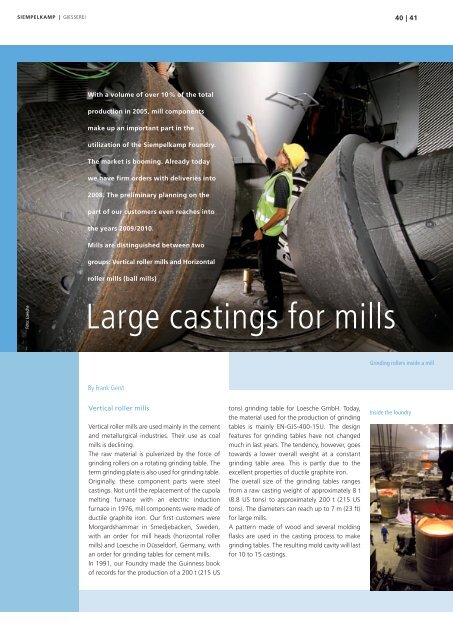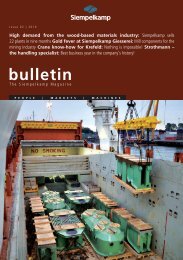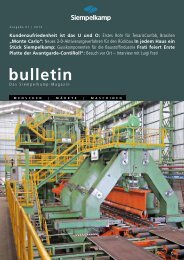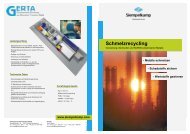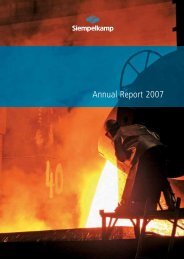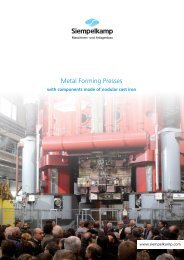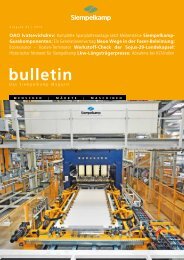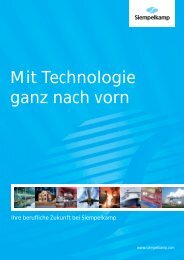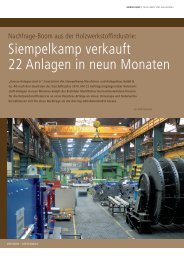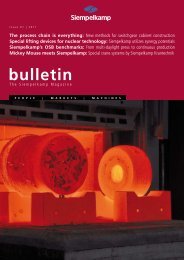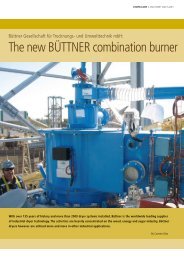Large castings for mills - Siempelkamp
Large castings for mills - Siempelkamp
Large castings for mills - Siempelkamp
You also want an ePaper? Increase the reach of your titles
YUMPU automatically turns print PDFs into web optimized ePapers that Google loves.
SIEMPELKAMP | GIESSEREI 40 | 41<br />
Foto: Loesche<br />
With a volume of over 10% of the total<br />
production in 2005, mill components<br />
make up an important part in the<br />
utilization of the <strong>Siempelkamp</strong> Foundry.<br />
The market is booming. Already today<br />
we have firm orders with deliveries into<br />
2008. The preliminary planning on the<br />
part of our customers even reaches into<br />
the years 2009/2010.<br />
Mills are distinguished between two<br />
groups: Vertical roller <strong>mills</strong> and Horizontal<br />
roller <strong>mills</strong> (ball <strong>mills</strong>)<br />
<strong>Large</strong> <strong>castings</strong> <strong>for</strong> <strong>mills</strong><br />
By Frank Gerst<br />
Vertical roller <strong>mills</strong><br />
Vertical roller <strong>mills</strong> are used mainly in the cement<br />
and metallurgical industries. Their use as coal<br />
<strong>mills</strong> is declining.<br />
The raw material is pulverized by the <strong>for</strong>ce of<br />
grinding rollers on a rotating grinding table. The<br />
term grinding plate is also used <strong>for</strong> grinding table.<br />
Originally, these component parts were steel<br />
<strong>castings</strong>. Not until the replacement of the cupola<br />
melting furnace with an electric induction<br />
furnace in 1976, mill components were made of<br />
ductile graphite iron. Our first customers were<br />
Morgardshammar in Smedjebacken, Sweden,<br />
with an order <strong>for</strong> mill heads (horizontal roller<br />
<strong>mills</strong>) and Loesche in Düsseldorf, Germany, with<br />
an order <strong>for</strong> grinding tables <strong>for</strong> cement <strong>mills</strong>.<br />
In 1991, our Foundry made the Guinness book<br />
of records <strong>for</strong> the production of a 200 t (215 US<br />
tons) grinding table <strong>for</strong> Loesche GmbH. Today,<br />
the material used <strong>for</strong> the production of grinding<br />
tables is mainly EN-GJS-400-15U. The design<br />
features <strong>for</strong> grinding tables have not changed<br />
much in last years. The tendency, however, goes<br />
towards a lower overall weight at a constant<br />
grinding table area. This is partly due to the<br />
excellent properties of ductile graphite iron.<br />
The overall size of the grinding tables ranges<br />
from a raw casting weight of approximately 8 t<br />
(8.8 US tons) to approximately 200 t (215 US<br />
tons). The diameters can reach up to 7 m (23 ft)<br />
<strong>for</strong> large <strong>mills</strong>.<br />
A pattern made of wood and several molding<br />
flasks are used in the casting process to make<br />
grinding tables. The resulting mold cavity will last<br />
<strong>for</strong> 10 to 15 <strong>castings</strong>.<br />
Grinding rollers inside a mill<br />
Inside the foundry
For large grinding tables, molding pits with a<br />
dimension of 8 m x 8 m (26 x 26 ft) are available<br />
in molding area 315. For 2007 three molding pits<br />
are firmly booked in our molding area 315 and<br />
another molding pit in molding area 313. A<br />
casting occupies a pit <strong>for</strong> approximately 3 weeks<br />
(pit molding, pouring, cooling).<br />
The main <strong>castings</strong> we produce <strong>for</strong> vertical roller<br />
<strong>mills</strong> are grinding tables, however, also smaller<br />
parts (levers, shanks) <strong>for</strong> roller <strong>mills</strong> are produced<br />
in our molding areas 311 and 312.<br />
Horizontal roller <strong>mills</strong> (ball <strong>mills</strong>)<br />
These types of <strong>mills</strong> have large horizontal<br />
rotating cylinders and are used in mining<br />
operations <strong>for</strong> grinding ore. Next to grinding iron<br />
ore, these <strong>mills</strong> are used in the mining of gold<br />
and copper. <strong>Siempelkamp</strong> manufactures and<br />
supplies the mill heads (single or multi-part<br />
<strong>castings</strong>) as well as gearings.<br />
These <strong>mills</strong> are classified by their type of<br />
crushing. Ball <strong>mills</strong> use grinding balls to crush the<br />
material. Autogenous <strong>mills</strong> (AG <strong>mills</strong>) act as ball<br />
<strong>mills</strong> using the incoming coarse, unground material<br />
as the grinding medium. Semi-autogenous<br />
<strong>mills</strong> (SAG <strong>mills</strong>) are a combination of both <strong>mills</strong><br />
using 3% to 12% of grinding balls in addition to<br />
coarse, unground material to crush the grinding<br />
medium. The feed size <strong>for</strong> these grinding balls<br />
ranges from 200 to 500 mm.<br />
According to their application area, these <strong>mills</strong><br />
can have an outside diameter of up to 14 m<br />
(46 ft). For smaller <strong>mills</strong> with a diameter of up to<br />
6 m (20 ft), the mill heads are cast in one piece.<br />
For larger mill heads, several segments are casted<br />
and then connected with bolts. Mill head<br />
segments come in 180°, 120°, or 90° designs.<br />
Contrary to the manufacturing of grinding<br />
tables, the molds <strong>for</strong> the mill heads and mill head<br />
segments are produced in a strickle molding<br />
process.<br />
The mill heads <strong>for</strong> ball <strong>mills</strong> are mainly made of<br />
EN-GJS-500-7U.<br />
The gearings are made of EN-GJS-900-2U. They<br />
are partly hardened and tempered afterwards.<br />
The gearings are also mainly multi-segment parts<br />
and are connected by bolts.<br />
Mechanical machining and transport<br />
Most customers request a complete delivery<br />
including the mechanical machining.<br />
The transport of the large mill heads to the<br />
machine shops is a challenge. Until 2002, a<br />
machine shop in Rotterdam could be reached<br />
com<strong>for</strong>tably via ship. Since it’s closed down, we<br />
have to use machine shops that can only be<br />
SIEMPELKAMP | GIESSEREI<br />
reached via truck. The picture on the right shows<br />
the transport of a 166 t (183 US tons) mill<br />
head.<br />
Apart from a special transport permit <strong>for</strong> such<br />
large cargo, a police escort and traffic controlling<br />
measures, which are time and cost intensive,<br />
are also necessary.<br />
The machining of both mill types is carried out by<br />
a vertical boring machine. While several machine<br />
shops can machine grinding tables up to 100 t<br />
(100 US tons), <strong>for</strong> the machining of larger<br />
grinding tables or mill heads only two to three<br />
machine shops are available within a radius of<br />
500 km (311 miles).<br />
The machining of grinding tables is carried out in<br />
two steps. First, the face area of the grinding<br />
table is machined. After turning the table, the<br />
lower surface, where the gearbox is later<br />
installed, is machined.<br />
Also the gearbox housings <strong>for</strong> the drives of the<br />
grinding tables are oftentimes produced in our<br />
foundry’s bay 315 <strong>for</strong> large <strong>castings</strong>.<br />
Depending on its design, the raw grinding tables<br />
are usually about 20% larger than the finished<br />
tables. Up to 40 t (44 US tons) of waste material<br />
is removed during machining.<br />
The mechanical machining of large mill heads<br />
(segments) is more complex because the flanges<br />
of the individual segments have to be machined<br />
Molding with a quality<br />
H2 pattern <strong>for</strong> a grinding<br />
table
SIEMPELKAMP | GIESSEREI 42 | 43<br />
Loading of a grinding table onto a ship<br />
first be<strong>for</strong>e holes can be drilled. After that, the<br />
segments can be connected with bolts and then<br />
the mill head can be machined as a complete<br />
workpiece.<br />
After completion of the machining processes<br />
and the acceptance of the workpiece by the customer,<br />
or a contractor, most of the workpieces<br />
receive a seaworthy packing.<br />
Depending on the customer and ship-to<br />
location, many different regulations have to be<br />
considered. This procedure results from the fact<br />
that more than 90% of all components are<br />
transported via ship overseas.<br />
The grinding table inside a Loesche mill<br />
As soon as the grinding table arrives at the construction<br />
site, the packaging material is removed<br />
and the table is completed with the parts that<br />
need to be attached (dam ring, grinding liner).<br />
The table is then lifted with a crane into the<br />
bottom part of the mill and attached to the mill<br />
gearbox.<br />
Finally, the rest of the mill is assembled and the<br />
mill is started up.<br />
The mill material is fed onto the rotating horizontal<br />
grinding table. The coarse raw material is<br />
transported to the grinding rollers by the rotary<br />
movement of the grinding table. The stationary<br />
grinding rollers roll over the material and pulverize<br />
it with great <strong>for</strong>ce.<br />
Transport of a 166 t (183 US tons) grinding table<br />
The rotary movement of the grinding table exerts<br />
a centrifugal <strong>for</strong>ce on the mill material, throwing<br />
it from the grinding table. To enable drying and<br />
grinding of the material at the same time,<br />
exhaust gas from a kiln enters the mill from<br />
below through the louvre ring. The gas transports<br />
the material upwards when the material is<br />
thrown off the edge of the grinding table by the<br />
centrifugal <strong>for</strong>ce. The material is then fed to a<br />
separator.<br />
The mill is powered via a vertical gearbox driven by<br />
a motor. Thrust-bearings inside the gearbox (below<br />
the grinding table) withstand the rolling <strong>for</strong>ces.<br />
Grinding parts that are prone to wear (e.g., roller<br />
tires and table segments) can be easily replaced.<br />
Loesche – The grinding expert<br />
LOESCHE GmbH supplies complete dry-grinding<br />
plants, or their single plant components, <strong>for</strong> the<br />
cement and metallurgical industries, as well as<br />
mineral and power generation industries.<br />
The company’s core competence is the development<br />
and construction of roller grinding <strong>mills</strong><br />
(LOESCHE mill) as well as the design, project<br />
planning, distribution, installation, and start-up<br />
of complete plants in which Loesche <strong>mills</strong> are used.<br />
Loesche is an independent and family-owned<br />
company founded in Berlin in 1906.<br />
Machining of a 38 ft mill head<br />
Lifting of a grinding table <strong>for</strong> installation<br />
in a Loesche mill<br />
Sectional drawing of Loesche mill<br />
Figure: Loesche<br />
Foto: Loesche


